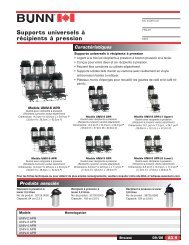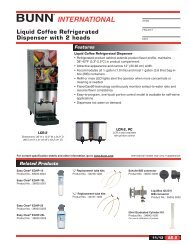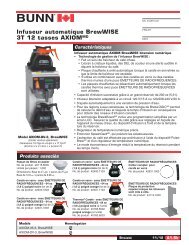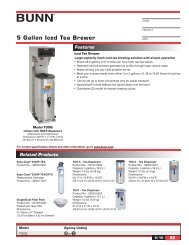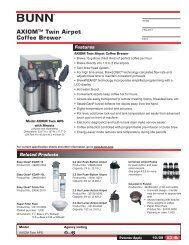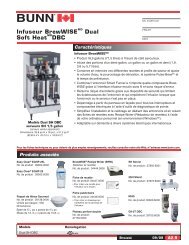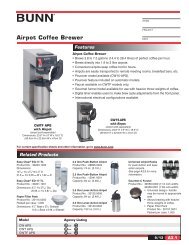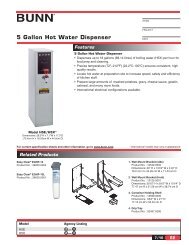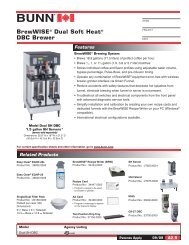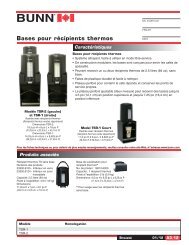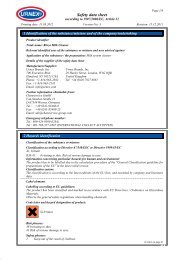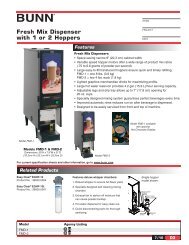Coffee Basics SCAA - Bunn
Coffee Basics SCAA - Bunn
Coffee Basics SCAA - Bunn
Create successful ePaper yourself
Turn your PDF publications into a flip-book with our unique Google optimized e-Paper software.
THE TECHNIQUE OF BREWING CONTROL<br />
COFFEE BREWING CONTROL CHART<br />
According to this chart developed through years of research and testing and now used by the Specialty<br />
<strong>Coffee</strong> Association of America, every great cup of coffee has three important variables—strength, extraction<br />
and brewing ratio. By plotting the relationship between these factors, it is possible to produce the ideal<br />
coffee flavor and drinking experience.<br />
Brewing Ratio | Ounces of Ground <strong>Coffee</strong> per Half-gallon<br />
Brewing Ratio<br />
The red diagonal lines represent brewing<br />
ratios of ground coffee used per halfgallon<br />
of water. The ground coffee<br />
measurements are displayed in ounces<br />
across the top and down the right side of<br />
the Chart.<br />
Strength (Solubles Concentration)<br />
The left side of the Chart indicates<br />
strength as a percentage. Other Control<br />
Charts may include total dissolved solids<br />
(TDS). The ideal percentage of coffee<br />
flavoring material in the finished cup is<br />
1.15% to 1.35%, and is most accurately<br />
measured by a Brew Strength Meter,<br />
hydrometer or refractometer.<br />
Extraction (Solubles Yield)<br />
Approximately one-fourth to one-third<br />
of a roasted coffee bean is matter that<br />
will readily dissolve in water during the<br />
brewing process. The other portion<br />
is bean fiber that isn’t soluble during<br />
normal brewing. The bottom of the Chart<br />
converts the fraction of the original dry<br />
ground coffee that has ended up in the<br />
finished cup to a percentage. The ideal<br />
range is 18% to 22% of the solubles.<br />
Grind size and brew time play a critical<br />
part in extraction.<br />
Optimum Balance<br />
Balancing strength and extraction<br />
produces a standard designated as<br />
“Golden Cup” by the Specialty <strong>Coffee</strong><br />
Association of America.<br />
USING THE CHART<br />
By using the weight of ground coffee in<br />
the brew basket, the volume of water<br />
used, and the strength of the brewed<br />
coffee, you can plot these to determine<br />
the extraction. The objective is to get<br />
to the Optimum Balance area. If you<br />
use 4 oz. of coffee and the strength of<br />
the brew was determined to be 1.40%,<br />
follow the red line labeled 4.00 oz down<br />
the red diagonal to the 1.40% grid line,<br />
and then straight down vertically to the<br />
bottom of the chart to extraction which is<br />
approximately 20.5%. Even though the<br />
extraction falls within the ideal range, this<br />
coffee is STRONG. To move the outcome,<br />
extraction needs to decrease to 18% -<br />
19.8% by decreasing the brew time and/<br />
or increasing the grind size.



